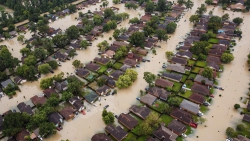Sep
13
2017

Written by Noelia Mann
We’ve seen this before. Natural disasters strike and communities of color and those affected by poverty are hit the hardest. As with the storms named Katrina and Sandy, it’s already clear that Harvey’s path of destruction will fall along racial and socioeconomic lines, and will also be felt long after the rains cease.
We know that most of the fatalities resulting from Hurricane Katrina were black people. After Superstorm Sandy, hundreds of black families waited for weeks for electricity, heat and in some cases, running water, to be turned back on. These previous examples of the impacts of environmental racism help explain why “the heaviest cost of Harvey’s destruction is likely going to be borne by the most vulnerable communities in its path.” As Charles Ellison from The Root noted “Not only does Harvey represent the permanency of climate change, but it also exposes those who are fast becoming the permanent victims of it: underserved populations ‘of color’ in densely populated urban cores.”
Grassroots nonprofit organizations who already work with and engage the people most vulnerable during these kinds of crises – people of Color, people affected by poverty, people without access to public or private transportation, people who don’t have health insurance or flood insurance, communities that don’t have access to food and grocery stores, undocumented immigrants, and the elderly and disabled – can contribute to the recovery efforts by both responding to the need and human suffering, but also by challenging how our nation responds to the disastrous effects of climate change.
As Manissa McCleave Maharawal and Isabelle Nastasia explain in Waging Nonviolence, our tools for recovery and emergency response must include “bottom-up organizing alongside mutual aid.” Nonprofits all across the country span that spectrum of organizing and aid in their everyday work with communities. But during moments of national crisis, that combination of meaningful engagement with those most directly impacted by systemic problems with the ability to meet the needs for support that communities identify is particularly crucial.
Photo Credit: Water from Addicks Reservoir flows into neighborhoods as floodwaters from Tropical Storm Harvey rise Tuesday. (Marcus Yam / Los Angeles Times)
